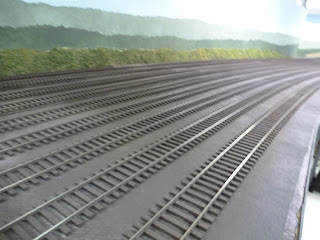Well, here we are in March, looking at the balance of the yard and main line that had to be painted and ballasted. A sea of stone is in my future.
Just before Covid hit, the guys gave me a hand with the start of the project. I had painted the track and the turnouts so we were ready for stone.
This is an overview of the area to be tackled - a lot of turnouts and track. Also not very accessible in some spots.
These views kept me from getting started when the guys could no longer come over.
Looking at it is not making it any easier.
Rich, being the youngest, had hopped up onto the layout to do the hard to reach spots before the virus hit. He is focusing on the main line here.
You can see he is working towards a completed section that was easier to reach
We use carpet remnants to protect the track when we work on top of the track
Here I set up for my last night with the larger crew. Then meetings were suspended.
Now I feel lonely
Only one ballast bowl out suffices now.
After about a month, most of the ballast is down. Now the problem is gluing it without disturbing it.
I used four colors. The main is a soft buff color. The arrival tracks are a grey and white blend, the branch tracks are a dark grey and the yard is black cinders, They are also different sized stone. Main and arrival are 30 grit, branch is 40 grit and yard is very fine sand.
Main line is done and a first coat of glue on.
.

T
he main and branch tracks will match the colors across the bridge
Once the stone has set with the glue, I paint the ballast to weather it.
The author in protective gear. I am even equipped for Covid!
The weathering really enhances the look of the ballast
Close to completion. Spraying the track also indicates where the glue did not cover.
I am collecting the tools in one place as I start clean up. It seemed like it took forever.
Here is a close up of the weathered track. Not heavy but some accents.
Here the cars have migrated to fill the space
I put this in to show how I indicate the location of the uncoupling ramps in the yards. When the ballast changes color, the ramp is located there. So, the black is where the cars should be uncoupled.
I have added some structures and I have also spent about 2 days getting all the turnouts freed up and working again.
The cabin track shows nicely here. The tracks to the right will be the work train and the clean out tracks.
Looks nice now
A modern interloper to test track power routing.
I added PRR concrete bumpers at several places. Next post will show them.
Approaching done
Done




































































